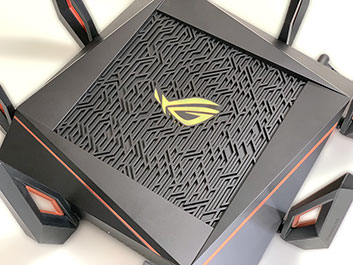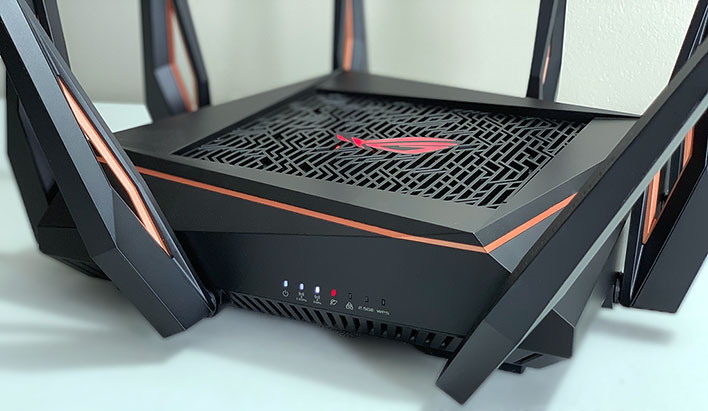ASUS ROG Rapture GT-AX11000 Router Review: A WiFi 6 Monster
ASUS ROG Rapture GT-AX11000: Hardware And Features
The ROG Rapture GT-AX11000 is one of two Wi-Fi 6 models that ASUS offers. Its other model is the RT-AX88U, a dual-band model with a slightly slower 5GHz band (up to 4,333Mbps compared to 4,804Mbps) and a 2.4GHz band with the same maximum throughput rating (1,148Mbps).
Both bring an aggressive design profile to the table, though the GT-AX11000 is definitely more monstrous in appearance. You can make your own comparisons—a headcrab, a spider that has been flipped on its back, or the head of demogorgon from the upside down. Whatever you want to compare it with, the GT-AX11000 is big and menacing.
It comes with eight antennas that line up neatly in the bottom of the retail box (they are removable). They are easy to screw in, and once you do, they add height to an already physically large router. It measures 9.5 x 9.5 x 2.4 inches (pay no attention to the incorrect dimensions listed on Amazon's product page), though with the antennas installed, the height jumps to just shy of 7 inches.
The shape of the router triggered my OCD. That's because it's not a perfect square—if you line up the rear of the router to sit flush with the edge of a desk, the front with its LEDs will be angled. This is further thrown off by the square-shaped vented top that does not align with the edges, and the general design. It gives the router character, which is what your dad would say if your drunk uncle built your puppy a doghouse after a night of binge drinking, and gifted it to you for Christmas. Sure, Billy, the roof is crooked and the entrance is off-center, but that's what makes it special—Sparky's going to love it!
Does your router RGB, bro? Or do kids say 'brah' these days? Either way, this one does. There is an ROG logo stamped on the top of GT-AX11000 that glows red out of the box.You can change this to any color you want, and can configure various effects: Static, Breathing, Rainbow, Comet, Flash, Glowing Yoyo, Color Cycle, Starry-Night, Strobing, and Wave. There's also an Event option that will change the LED color based on various triggers. They are described as such...
- Game Boost: When enabling Game Boost, you will see Breathing in red on the LED bar.
- Traffic Meter: Rainbow LED shows your real-time traffic, and it changes the color combination according to your Internet speed.
- Log-in Fail: When failing to log in, you will see Comet in red on the LED bar.
- Attack Block: When the system successfully blocks a potential attack, the LED shows Comet in red.
You can also disable the LED, as might be desired if setting the router up in a bedroom or otherwise not wanting to be distracted by a glowing light.
Additional status LEDs (white) string the front. From the left to right, these indicate the status of power, 2.4GHz/5GHz Wi-Fi connectivity, WAN (Internet), LAN, and the 2.5G gaming port.
Three inconspicuous buttons on the left side of the router allow you to toggle Wi-Fi connectivity on and off, connect devices via WPS, and perform certain actions that you bind in the dashboard, to what's called the Boost key.
By default, the Boost key turns the ROG logo LED on or off. However, you can configure it to toggle on and off all the LEDs (both the ROG logo and the front status indicators), toggle the use of Dynamic Frequency Selection (DFS) channels, or toggle the Game Boost function, which prioritizes gaming packets. The latter option is essentially an Adaptive QoS scheme. There are also separate Adaptive QoS schemes for media streaming and web surfing, and a customize option that lets you set a hierarchy for gaming, video and audio streaming, VoIP and instant messaging, web surfing, file transferring, and others.
The GT-AX11000 sports four LAN ports, as is commonly found on most routers, and of course a WAN port. Given that this is a top-shelf router, it is bit of a bummer that ASUS did not bake in an eight-port LAN switch, particularly given the target audience—gamers put a higher value on wired connections than the average user does.
ASUS mitigates the potential disappointment, however, by including a 2.5G 'Gaming' port, basically a multi-gig LAN port (2.5G Base T Ethernet).
Now let's have a look at the dashboard...













